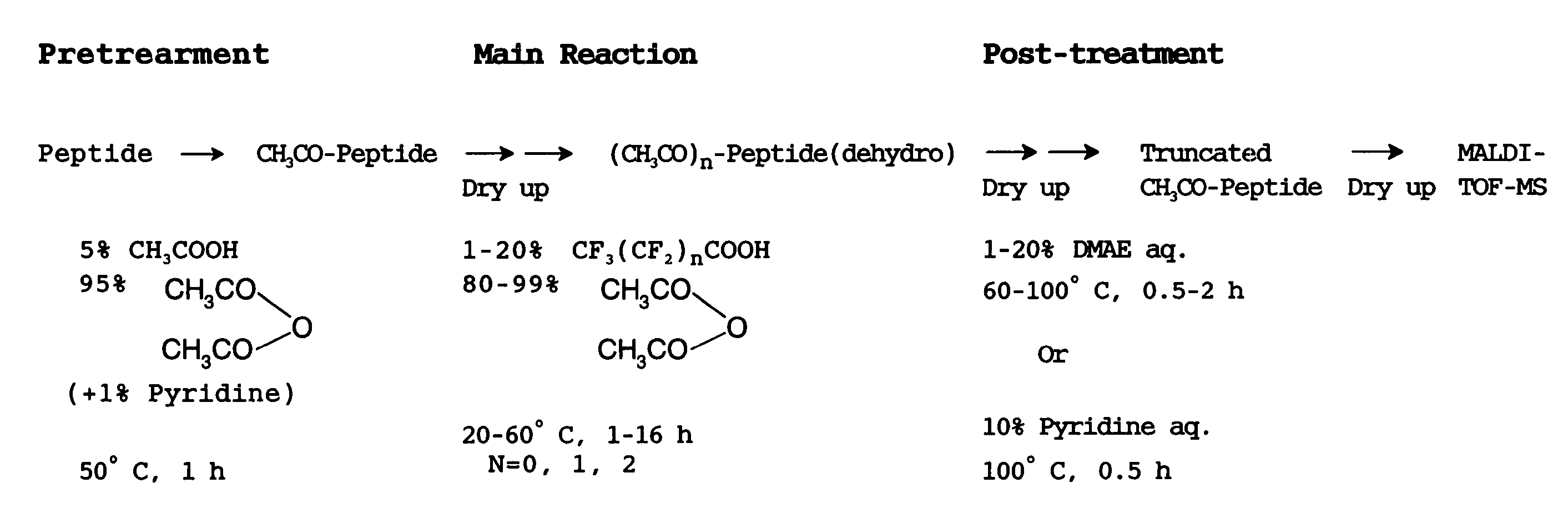Method of analyzing peptide for determining C-terminal amino acid sequence
a technology peptide, which is applied in the field of c-terminal amino acid sequence analysis of peptide, can solve the problems of interfering with accuracy and practical problems of methods, and achieve the effects of avoiding side reactions effectively, increasing the possibility of undesired side reactions, and increasing the possibility of side reactions
- Summary
- Abstract
- Description
- Claims
- Application Information
AI Technical Summary
Benefits of technology
Problems solved by technology
Method used
Image
Examples
example 1
[0103]In order to verify the usefulness of the method for analysis of the C-terminal amino acid sequence of peptide according to the present invention, analysis of C-terminal amino acid sequence was conducted for human angiotensin I, which is a peptide comprising 10 amino acids.
[0104]With respect to human angiotensin I, which is the peptide to be examined in the present Example, its amino acid sequence is already known to be Asp-Arg-Val-Tyr-Ile-His-Pro-Phe-His-Leu. Using this peptide, the precision of identification for the C-terminal amino acid sequence analyzed by means of the analysis method according to the present invention was verified.
[0105](Pretreatment Operation)
[0106]First, a peptide solution containing 10 pmol of commercially available human angiotensin I is fed into a micro vial and subjected to a freeze-drying treatment. The vial containing the dried peptide sample was set in a glass-made reactor of air-tight test tube type with fitting stopper, having an evacuation por...
example 2
[0128]In this Example, it was verified that there occurs no progress of side reaction that may result in serious problem even if the reaction temperature varies slightly during the reaction of successively releasing C-terminal amino acids, because mild treatment conditions are employed in the treatment technique for selectively releasing C-terminal amino acids according to the present invention. In particular, the treatment temperature employed for the reaction of releasing C-terminal amino acids, which is included in the series of chemical treatments described in Example 1; was changed from 40° C. to 50° C., and the reaction products obtained in these two case were compared with each other.
[0129]There were chosen the same procedure and conditions for each operation as the operational procedure and conditions described in Example 1, with the except of said change in the temperature for the reaction of releasing by using acetic anhydride with 5% by volume of trifluoroacetic acid adde...
example 3
[0132]In said cases of Example 1 and Example 2, the pretreatment operation was carried out in order to modify the N-terminal amino group of peptide for its protection. In the present Example, it was verified that no side reaction causing serious troubles takes place even when the pretreatment is not carried out, because, in the process for the chemical treatment according to the present invention, at the step of carrying out the treatment of successively releasing C-terminal amino acids, a peptide sample used is dried up in advance into a solid phase, and the reaction is promoted by supplying both acetic anhydride and trifluoroacetic acid in a vapor phase, which are utilized in the reaction.
[0133]Specifically explaining, the pretreatment described in Example 1 was omitted, and the operation for the reaction of releasing C-terminal amino acids and the subsequent post-treatment operation were conducted to a dried sample of human angiotensin I. In this case, in the operation for the re...
PUM
| Property | Measurement | Unit |
|---|---|---|
| temperature | aaaaa | aaaaa |
| temperature | aaaaa | aaaaa |
| pKa | aaaaa | aaaaa |
Abstract
Description
Claims
Application Information
 Login to View More
Login to View More - R&D
- Intellectual Property
- Life Sciences
- Materials
- Tech Scout
- Unparalleled Data Quality
- Higher Quality Content
- 60% Fewer Hallucinations
Browse by: Latest US Patents, China's latest patents, Technical Efficacy Thesaurus, Application Domain, Technology Topic, Popular Technical Reports.
© 2025 PatSnap. All rights reserved.Legal|Privacy policy|Modern Slavery Act Transparency Statement|Sitemap|About US| Contact US: help@patsnap.com



